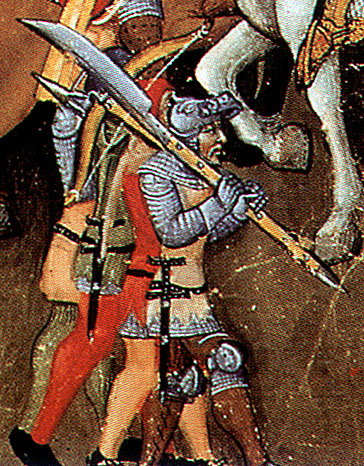Posts: 57 Location: Nelson, New Zealand
Sat 06 Jun, 2009 7:46 pm
This was an interesting Post - has anyone picked up any new intelligence about hardened leather defences in the past year and a half?
I have seen an experiment in water hardened leather in which boiling ruins the leather (crispy and massive shrinking) and bringing to a set heat well below boiling resulting in a piece of hardened leather that easily handled a meat cleaver chop while sitting on a chopping block. However in saying that in a historical context the piece would need to be replaced before the next battle. Which may be the suitability of using leather as a defence especially over an another armour (either padding or
maille) as it would be easy to replace compared to metal. I am not sure about it being cheaper. Some where in the previous post someone mentioned that leather was cheap being a by-product on the beef industry. It is one now and leather is not currently that cheap. If it was cheap in period then it would make it even better as a replaceable armor. The fact that a tanner would have to have a full cow hide pickling in a tanning pit for up to 18 months would be a slow way to make your fortune!
I would also speculate that beef was not as accessible to all levels of society as it is now and may have been an expensive meat choice even with the poorer cuts. In fact in terms of production value vs resource use you'd be better off with 3-5 head of sheep compared to 1 cattle beast over a two or three year life. Most of the period illustrations that I recall that have cattle shown are pulling carts or ploughs and that may have been one of their primary benefits combined with milk, meat and hides. Hopefully someone more well read in period animal husbandry may be add more to this...
Native American also had rawhide
shields made from full thickness hides from the neck of the buffelo, which was proof against musket shot. I have handled a full thickness rawhide from a cattle beast and it was thick, dense but amazingly light. I would guess that the African tribes that used rawhide shields would have selected the appropriate area of hide to make their shields from. Modern dogchew rawhide is a by-product of the leather tanning industry (the straggly bits of belly that are trimmed off prior to tanning) so may not be a good approximation of period rawhide.
If water hardening was the primary way of hardening leather then the armourer would have selected the best part of a hide for the job. The hardening experiment I have witnessed showed that different parts of a hide stretched in different directions according to the location of the piece on the hide. Ie belly really stretchy and shrank more along the back-belly axis rather than the head-rump axis. The hypothesis was that the collagen buildup had stretched out in one direction more than the other. Any imperfections in the hide also showed up as distortions in the piece. Following on from that the hide from over the rump may have been the preferred choice.
As Al M has mentioned above pit-tanned leather has a far denser consistency compared to modern vege-tanned leather, and the shrinking we see in modern VT may not have been so significant, which is our biggest problem in trying to water-harden leather.
So when we look at water-hardened leather we can say (among other things) that there are these points;
Annoying shrinking habits of water heated leather
An armour that may have been trashed after any medium to serious damage
An armour that may require intense maintenance
which are issues to re-enactors (as amateur manufacturers and warriors, with full time jobs etc) but probably not an issue to a wealthy fighting man within period with access to a well developed industry and serfs!
Thanks for reading my ramblings - let the discussion begin anew!
Cheers
Boyd
